About this blog: I intent this blog to help you take a self-guided photography tour to the by-lanes of Kumartuli, where Durga Idols are made. An intense destination for a culture lover, Kumartuli is an old neighborhood by the banks of Ganga, tucked in the old dingy lanes of North Kolkata, Uttar Kolkata as Bengalis say. It is here the famous Durga idols (‘Kumartulir Daker Saaj’ fame) are built of clay before the grandest festival of India, Durgapuja beckons in Kolkata!
Read more on Kolkata from a local: Where to eat in Kolkata and things to do in this metro city- all articles here!
Disclaimer: What may look like “nude” in western eyes, is worshiped by billion people. Respect is the best thing I learnt as a traveler.
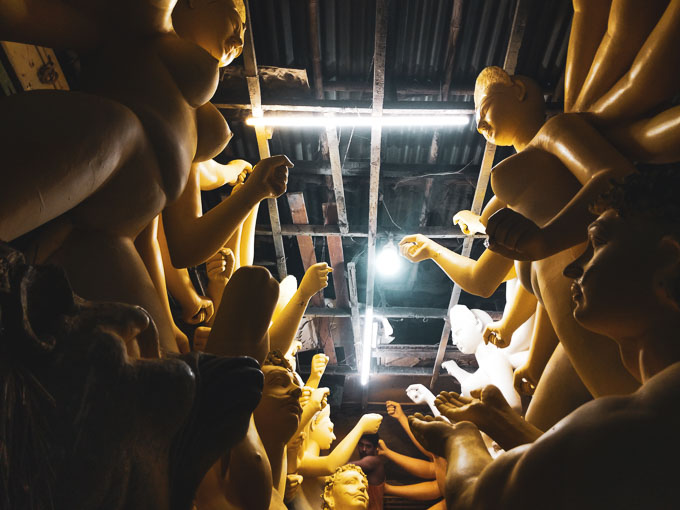
Durga Idols and Kumartuli at a glance: things to know before you go!
The best time to visit Kumartuli
Kumartuli picks up pace before the start of Durgapuja. From August to October, you shall see the gradual evolution of the Durga Pratimas (idols) from clay and straw structures to beautiful feminine figure, perceived as the mother supreme for Bengalis!
Regular work starts at Kumartuli as early as 6 am. However, visitors are requested to visit Kumartuli from 12 noon onwards. The Durga idol makers’ workshops are open till 12 at night!
Kumartuli can be visited even when the season is not of Durgapuja since Bengalis celebrate “baro mashe tero parbon!”, a local idiom pointing out Bengalis have 13 festivals in 12 months. However the grand structure of Durga idols can only be seen before Durgapuja. Durgapuja in Kolkata generally takes place in October.
Also read: Kolkata Durgapuja- a photo essay with more than 50 stunning pictures!

Entry fee to Kumartuli
With a number of photographers entering the bylanes of Kumartuli and pointing their lens to the Durga idols on the make, authorities have imposed a price to the Photowalk at Kumartuli.
The daily entry pass to Kumartuli is INR 20. If you want to visit multiple times in a season, you can pay INR 100 once. This pass can be transferred.
Before you click a picture, ask for permission or buy the ticket.
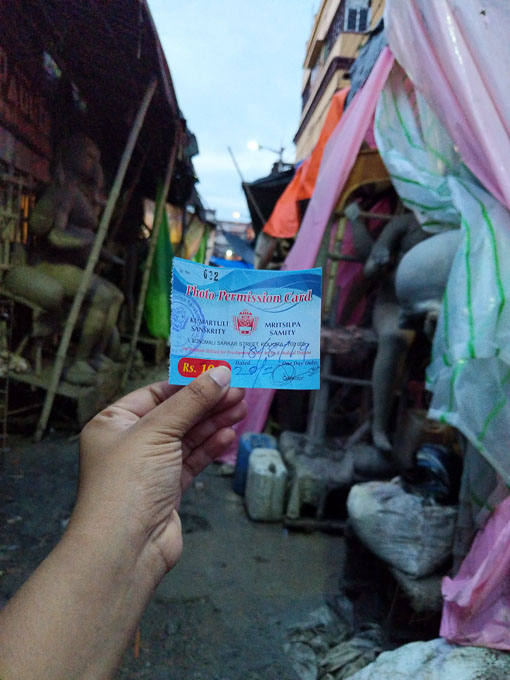

The History of Kumartuli: Where Bengal’s Durgapratimas are Made!
History of Kolkata’s opulent Durga puja celebrations coincides with that of Britishers setting their foot to the edge of ‘Ganges’! The last Nawab of Bengal, Siraj Ud-Daulah lost his throne. Nabadwip’s Hindu king Krishnachandra joined hands with the British. The city of Calcutta was established with three Bengali villages, leased from the king.
The Babu culture of Kolkata steeped deep inside the social fabric of Calcutta, capital of then British India, resulting in proverbial Durga Puja celebrations of the days of yore, where the poor of the village would be eating at Zamindar’s house for months at a stretch.
Also read, how to plan a trip in Kolkata during Durgapuja!
Pin it for later!
Back in 1932, the Bonedi Barir Durgapuja (the Durgapuja celebration of royals) of Kolkata was slowly dying as British took off their interest. British finances were directed from the grandeur of religious celebration to elsewhere. The era stood witness to an eventual transit to the Barwari Pujas (a Durgapuja dedicated to one locality or the para, by the people, of the people, for the people).
Kumartuli fell prey to the slump and engaged the young from the community to supply households with the finished idols in the dark of the night! If you delve into the Samachar Darpan, a newspaper in circulation in the days of undivided Bengal, you will find opinionated articles condemning the childish act that put Bengali Babus to an uneasy position.
After all, Durgapuja requires undivided attention and unending resources, apart from dedicated humans! (Reference: Kolkata by Sripantha)
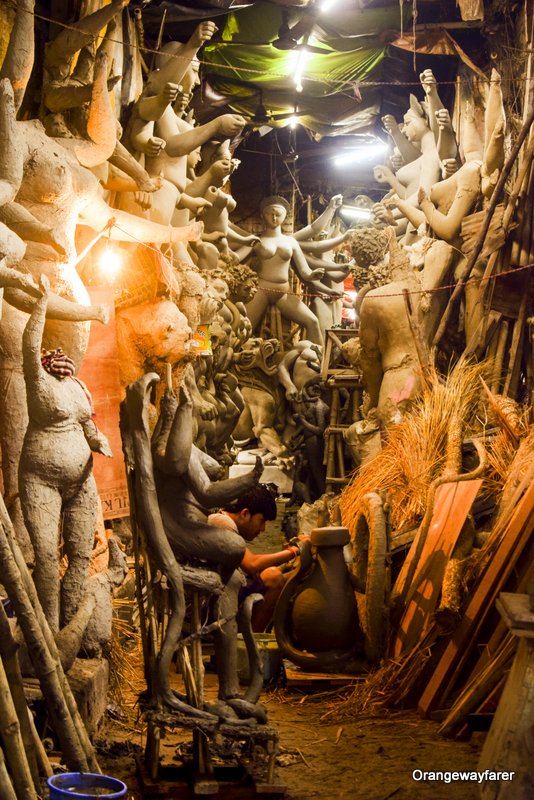
At Kumartuli, Durga Idols can only be made to order and not sold off the shelf.
A Durga Idol will have ten hands, each hand shall have a weapon. She stands triumphant atop a lion, with a trident pointed at Mahishashura, the Buffalo-Demon, who has a cobra snake in one of the hands. She will have 4 other deities by the side, Lokkhi, Ganesh, Kartik and Saraswati, believed to be her children.
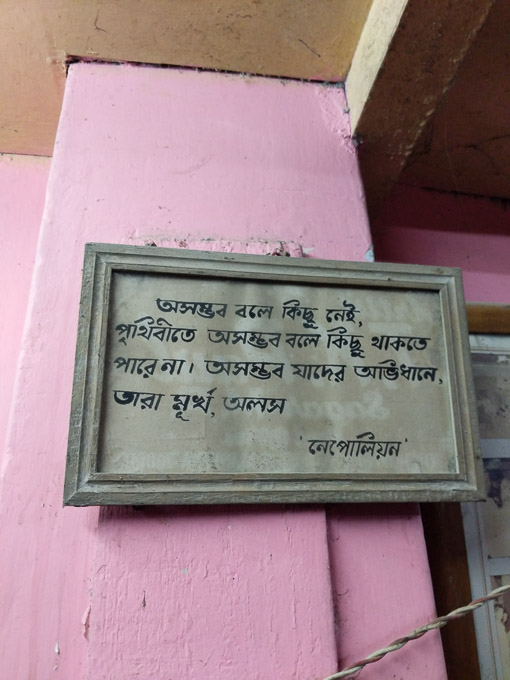
A cluster of Durga Idols on the make. Do note the artist in the picture giving shape to the clay. The Gangetic clay is taken everywhere out of the banks of Hoogly river to give a final touch to the idols. This, I learnt from the potters who work in the workshop at Cox Town, Bangalore!
“গোবিন্দরামের ছড়ি, উমিচাঁদের দাড়ি, নকু ধরের কড়ি আর মথুর সেনের (পদান্তরে বনমালী সরকারের) বাড়ি।”
Legend has it Jagatseth’s money, Umichand’s beard, Banamali Sarkar’s house, and Govinda Mitra’s walking stick contributed to the idea of Kumartuli! All of them were the Zamindars, Indian term of landlords from the days of yore! They even helped the east india Company with lending money at certain times.
At Sayantan’s house, Durgapuja used to be the norm of the family on every Sharat season. Traditionally the potter would come home, make an idol for days and the family will engage in worship. Legend has it the arrangements were devoid of a sheen on a particular year and caused death for a child in the family. They stopped Durgapuja at home. The potter went back to Kumartuli with his paintbrush wrapped in a Gamcha.
A man furbishing the idol with a caring touch behind the sheets protecting from Kolkata monsoon! I often wonder, how does it feel to see the idols immerse after they have put in their hard work for days and nights?
Kumor Parar Gorur Gari (the ox-driven cart of the potters’ village)… our childhood rhythms in these Sohojpath lines by Rabindranath Thakur! Kumor (the potters) were the caste (and not in a casteist way) who excelled in the art of earthen wears! The sticky clay of Ganges melted easily in their hands, taking many shapes and forms, further to be dried under the sunrays or baked in the flames of fire.
Every year, around 15000 idols are sold off around the globe!
Idols were made and further painted for Life to be instilled. “Matrirupenu Sonosthitha!” A Sanskrit phrase calling the idol a mother!
Durgapuja dates for 2019
Mahalaya: 28th September (Saturday)
Panchami: 3 October (Thurseday)
Shashthi: 4 October (Saturday)
Saptami: 5 October (Sunday)
Ashtami: 6 October (Monday)
Nabami: 7 October (Tuesday)
Dashami: 8 October (Wednesday)
Spotted a Spiderman at the entrance of Kumartuli!
If you thought Kumartuli busies herself in making Durga Pratima only, think again. The world cup frenzy in the world gets their lifesized inspirations built and exported from this humble potter para in Kolkata!
Also read, a melancholy post Durgapuja!
It is impossible to have a cultural place in Bengal where Rabindra Nath Thakur is not present.
The tradition changed with the advent of technology. The potters’ sons acquired varied skillsets and proceeded to different sectors of life. Like every other industry, a few artisans stayed true to their art. They sustained many blows of modernism, land encroachment and yet continued to create life in idols made from the entel maati (the sticky Gangetic clay).
Dating back to the old days of British Raj in Calcutta, the soul of East India Company in the early 19th century, Kumartuli was a road frequented with palanquins, Babus and faithful devotees heading for the Ganga ghat. Coomertolly, the old-fashioned British spelling is still inscribed on the ghat.
Moi standing in front of a Durga Idol at Kumartuli on the day of Shashthi. The last few days before the festival (Durga Puja) starts, Kumartuli takes up the busiest speed!
From that, the transformation into a “photo walk hotspot” in Kolkata is a direct boon of technical prowess that rocks twenty-first century India, ready to go social every other second, sharing lived experiences. However, much like the photographers, technology had to stop at the doorstep of the studios, made of plastic and tarpaulin sheets, inside which the artist potter sits, busy in idol-making in the dying faint light of a kerosine lamp.
An Artist and his devotion to the work! He is making the face of Durga idol. Notice the upside down idol faces on the ground.
Legend says that the king of Krishnanagar appointed a potter to create a Durga idol to commemorate the win of British ober the last Nawab of Bengal Sirajudullah. Eventually, a lot more Bonedi baris pitched in for a Durga idol. The potter was granted land to start his business which grew up to be the sprawling Kumartuli as on today!
Close to 200 families live in Kumartuli. There are more than 500 “studios”, work chamber for the artisans. In the true spirit of a community, Kumartuli is a homegrown age-old cooperative brand. From Houston to Sydney, Kumartuli’s Durga Idols are literally globe trotters!
The Making of Durga Idols at Kumartuli
Artists in Kumartuli stay grounded to nature. Clay from the banks of Hoogly, rains, sunshine and the humid heat of Kolkata are necessary ingredients used in Kumartuli to create a lifesize idol on the staw and bamboo framework! Post which the clay art is formed.
However, the firth handful of clay that goes to the Durga frame is derived from the doorstep of a prostitute. Also known as Vaishya mati, (Mati is Clay in Bengali), this is symbolic to show respect to the women of the world. Durgapuja, as it is celebrated in the twenty-first century, is a truly inclusive festival!
It takes a while to dry up. “Rain is our real Asur!” exclaimed an old potter as I was filming inside the narrow lanes of Kumartuli. Prolonged rained delays drying up, taking new projects and stalls the work as a whole.
Chokkhudan or drawing the eyes of Durga Idol
While the entire process of making a Durga idol is awe inspiring, the Chokkhudan or drawing the eyes of the Godess is supposed to be of prime most importance! Ace artists paint the eye in one stroke of the brush, after a few brief moments of contemplation, it is said. It is an honour to experience that brush stroke, as you are let into witnessing a very private world of human turning into creator!
Three schools of idol making are prevalent in Kumartuli. The traditional one is Dhaker saj (we will discuss it in a later section). The other two are Bangla and ARt Bangla. These days, students of national art school and eminent artists are also trying hands at Durga idol making in Kolkata.
A Durga Idol riding on a lion and the Asur near her feet at Kumartuli on her way in search of sunshine?
The bright sunlit days, on the other hand, speeds up the process. Meanwhile, the Idol’s heads are built and often burnt in the flames.
The process of creating Durga idol is time-consuming and can take anywhere between 3 to 6 months. The generic practice is to start the work from the day of Ratha Jatra, marking an auspicious beginning. The process begins with the potter worshipping Ganesh, believed to be Durga’s son!
Found a Unicorn in the idol workshop at Kumartuli, Kolkata!
Create and Destruct: the Cycle of Life!
The skeleton of an idol is made of straw, bamboo, jute and clay: everything organic and reused every year. After the idol has been immersed in the water, the framework stays afloat, the clay goes back to the river/pond.
Kumartuli’s client portfolios have extended in different parts of the world. Antarctica is yet to be brought into the portfolio though!
The workshop number hovers around 550. The number of idols being made is close to 15000. All are a rough estimate as procured from an artisan at Kumartuli.
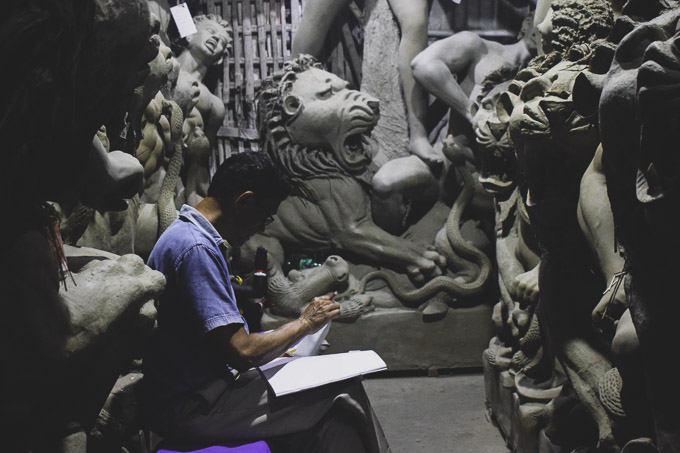
The New Age Practice of Choosing Organic Colour at Kumartuli: An Eco-Conscious Choice!
Much has been talked about the colours used as a mode of painting for the Durga idols. The chemical induced in the colour palette had been polluting river Ganges beyond repair. Thankfully the new age artists have mostly shifted to eco-conscious choice for painting the idol. The Gorjon oil used to glaze the idol’s face is my favortite pick from the choice of organic materials on use.
Gopal Puja celebrated in Bagbazar area with a collective fund from the artisans of Kumartuli. The money collected is locally known as Britti. (Picture Courtesy: Saswata Mondal from the Facebook Group Purano Kolkatar Golpo)
The face of Durga is often called the epitome of native Bengali beauty. “Ma Duggar moton Mukhkhani”, as they say, necessarily denoting Gourabarna (fair), large eyes, curly hair. Traditionally, she will be adorned with red saree.
Sri Dhakeswari Temple, Kumartuli
The partition of Indian subcontinent rendered the Gods homeless as well as their subjects. Dhakeswari temple in Dhaka, capital of Bangladesh and now conserved as the national temple, was plundered several times before partition. The deity, Durga in the form of Katyayani Mahishashur Mardini, made of gold and Ashtadhatu, was brought into Kolkata with the refugee family.
Sri Dhakeswari temple at Kumartuli was established for her. During Durga Puja, the worship takes place following the rituals of Navaratri, the same of that in north India.
The intricate work on the face of Durga idol. Completely hand painted! Note the wide eye which is very specific to the Durga Pratima of Kumartuli, Kolkata.
Daaker Saaj on Durga Pratima in Kumartuli!
While the idols are made into many shapes and size, even abstract at times, the authentic Kumartuli Durga idols are meant to be decorated with Daaker Saaj. Daak is the Bengali work for mail. The silver foiled materials used to decorate the idols were imported from Germany via email!
Sholapith is a material more in use by the commoners. Retrieved from a spongy plant matter, the ivory white shola emphasises the typical Bengali face of the idol, with wide eyes, vermilion on the parted hair, and the third eye!
Appreciating the detailing of a door at an old Kolkata house at Banamali Naskar Lane, Kumartuli, Kolkata.
Walking in the lanes of North Kolkata is magical! We stumbled upon this old place that sells transistor radios of a bygone era. The shop owner ensures that all of them are in working condition. This shop is located the end of Kumartuli lane.
We paid only 10 Rs to enter the Kumartuli Para. 10 Rs is all that you pay here to click the artists at work. Granted, the idols are priced steeply and sold worldwide, however, I took some time to settle with Rs 10 as “Unnoyon Chanda” for Kumartuli Somiti! The dwindling streets branches out into many workshops on both sides.
I went in July when the onset of monsoon rain had caused havoc on the work. We were told to stand outside the workshop and legitly so. The Entel maati was visibly wet. I could not risk breaking the lion’s teeth, could I?
Durga idols are made first. Then the artists start making the children of Durga: Ganesh, Karthik, Lakkhi and Saraswati!
Breaking the Stereotypes: The Female Artisans of Kumartuli!
Even though the idol is a feminine identity, the workshops at Kumartuli is a men’s world. I could hardly find a woman at work. “Our women take care of the household!” The potters said. However, I found these names of lady artists of Kumartuli, China Pal and Maya Pal. A school drop out at the age of 15, Maya Pal has been recognised for her artwork for last three decades and won many accolades. Do look out for her when in Kumartuli.
The lanes were accommodating to “outsiders” as well. A few Mass Comm students from Delhi University were shooting a short film. Their props included a hand-pulled rickshaw. The owner of the rickshaw was chilling by the sidewalk and smiling as the boys try to pull the historic mode of commute with all the force humanly gathered! A group of school children came to visit with their teacher as well. I learnt it is a part of “know your city campaign”!
Besides Durga idols, artists also make Lakkhi for regular worship in Bengali households!
The Easiest Way to Reach Kumartuli, Kolkata
The nearest metro station to Kumartuli is Shovabazar Sutanuti. From Shovabazar metro, Kumartuli is a mere 10 minutes walk through the heritage buildings of North Kolkata.
From Part Street or Downtown Kolkata, you can take a taxi to reach Chitpur area as well.
If you are coming from the side of Howrah, take the steamer to Shovabazar ghat and walk for a few lanes to reach Banamali Naskar Lane. Banamali Naskar lane and surrounding area is generally known as Kumartuli!
The Best time to Visit Kumartuli to see the Making of Durga Idols
Anytime prior to Durgapuja is the best time to visit to find the potters busy at work and capture the artistic prowess in your lens. Dates around the event of Mahalaya are suggested since you can catch a glimpse of Chokkudaan (painting the eyes) as well as most of the Idol framework will be painted. Do understand, the closer the dates are to the event of Durgapuja, the more will be the crowd pull!
The potters of Kumartuli rely heavily on naturally sourced ingredients. Flour made of tamarind seeds is mixed with paint. The thick gummy mixture holds the sculpture better.
Beyond the Durga Idols, Explore Banamali Naskar Lane, Kumartuli!
When at Kumartuli, following are my favorite things to do:
- Meet and greet the river Hoogly flowing by the side. Drink a cup of piping hot Cha served on a clay pot!
- Eat some Gaja and Telebhaja from the streetshops
- Visit the Kashi Mitra Shoshan Ghat (cremation ghat) where the Hindu community burns their deads
- Take a boat ride on river Ganga (this branch here is known as Hoogly river) from Shova bazar ghat
- Visit the Baranagar ghat where evening Aarti takes place
- Visit Sri Dhakeswari Temple, a century old Kali temple of Kolkata
Kumartuli is situated at the heart of North Kolkata. Ask any Bengali about the charm of old Kolkata and you will be flooded with a soaring tale of nostalgic past. How the eminent personalities, the freethinkers of the old days, the pioneer of Indian renaissance had walked past these roads, how the buildings were made with care and passion.. the stories are endless! That said, you can soak in the grandness of Kolkata history only if you are familiar with the city!
A plaque reading the house of Nabin Chandra Dash who invented the famous Bengali sweet name Roshogolla! (Picture courtesy: Santanu Banerjee)
This house is supposed to be beside another famous old house of Kolkata named Putul Bari (Doll House) which is rumoured to be haunted!
A boat crosses river Hoogly, a major distributary of river Ganges and takes the Durga idol to Bali. (Picture Courtesy: Soumen Chatterjee from the Facebook Group Purano Kolkatar Golpo)
However, I suggest you walk past the narrow Kumartuli lanes. The legendary narrow lanes of North Kolkata will surprise you pleasantly!
Watch out for the typical “bonedi baris” of North Kolata, hues in bright red, put into legal conflict by the heirs, housing the tenants who pay around INR 10 or 20 since time immemorial (yes, that’s a thing in North Kolkata), often tagged as haunted.
Sometimes, Kolkata municipality has hung a board stating the house is dangerous and can break down any time! There are houses with a plaque in front, stating how Ramakrishna had visited one of his benevolent disciples.
Some of these Bonedi bari celebrate Durgapuja in their own traditional way which is a delight to watch and brings back sheer nostalgia!
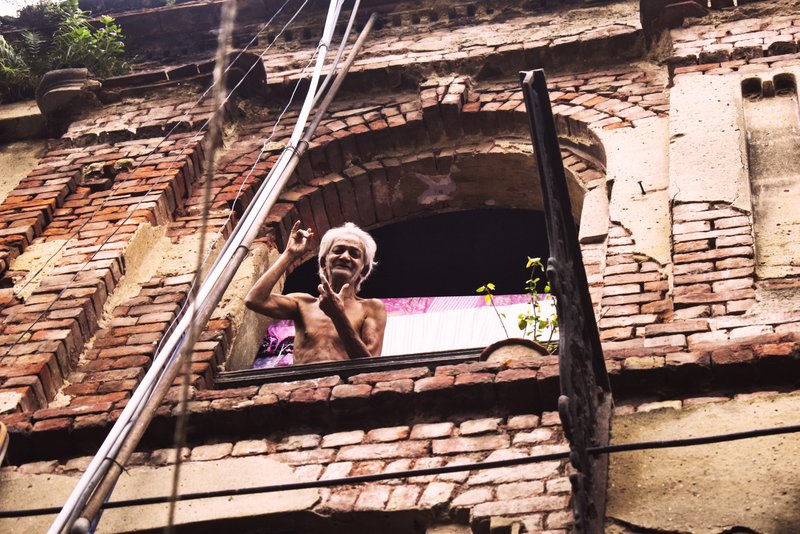
Unconditional love! An old man greeting us as we were walking past the old lanes of North Kolkata! Reasons why I love the city!
Kumartuli is a place where the eternal dream of old Kolkata lives and thrives. Lion-faced water taps, hand-pulled rickshaw, ancient trams like a sloth bear; the ensemble is a feast for your nostalgia! Yet, the World wide web has entered the lanes of Kumartuli, where bamboo frameworks come closing in on a new visitor. Resistance from what? I am yet to find an answer!
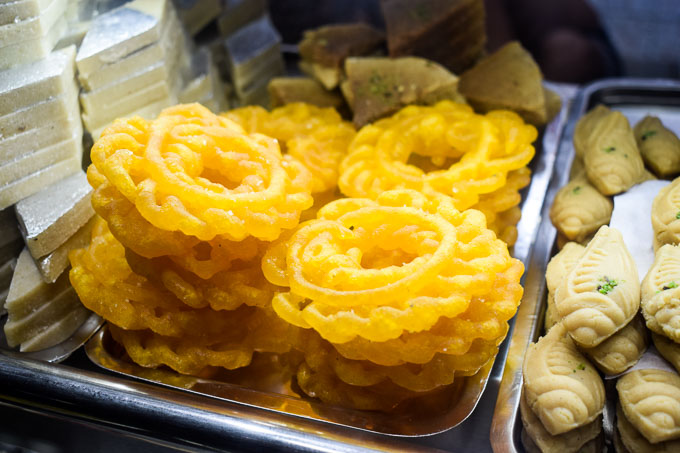
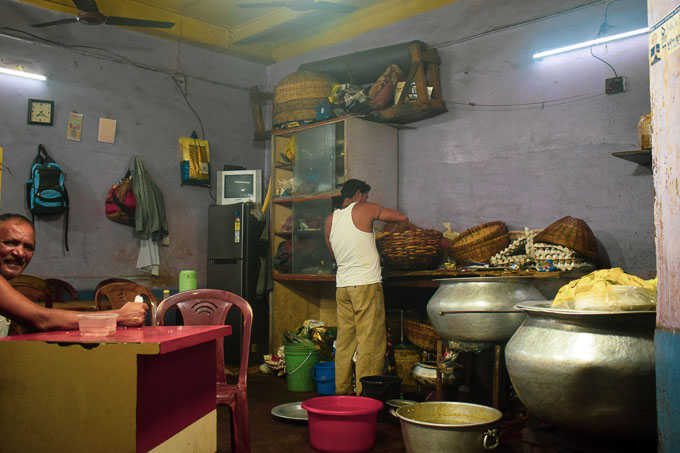
Watch the Kumortuli Vlog here!
Loved the read? Pin it for later!
Want to get real time updates of my travels?
Get updates and read additional stories on the Orange Wayfarer Facebook page.
Follow Orange Wayfarer on Instagram.
Follow Orange Wayfarer on Twitter.
You may also subscribe to my weekly newsletter!
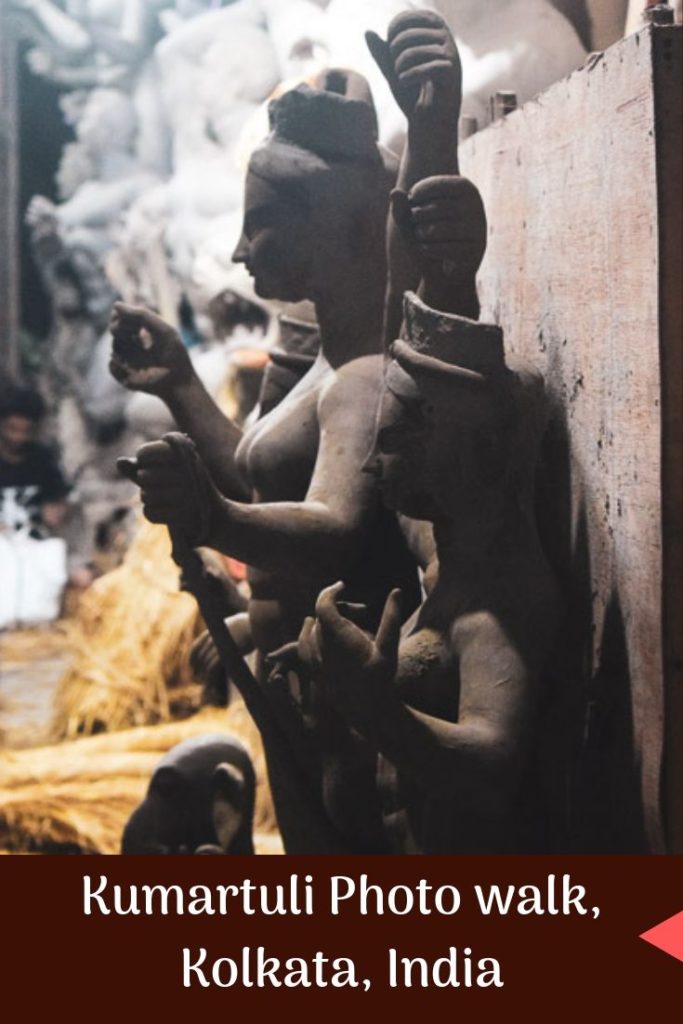
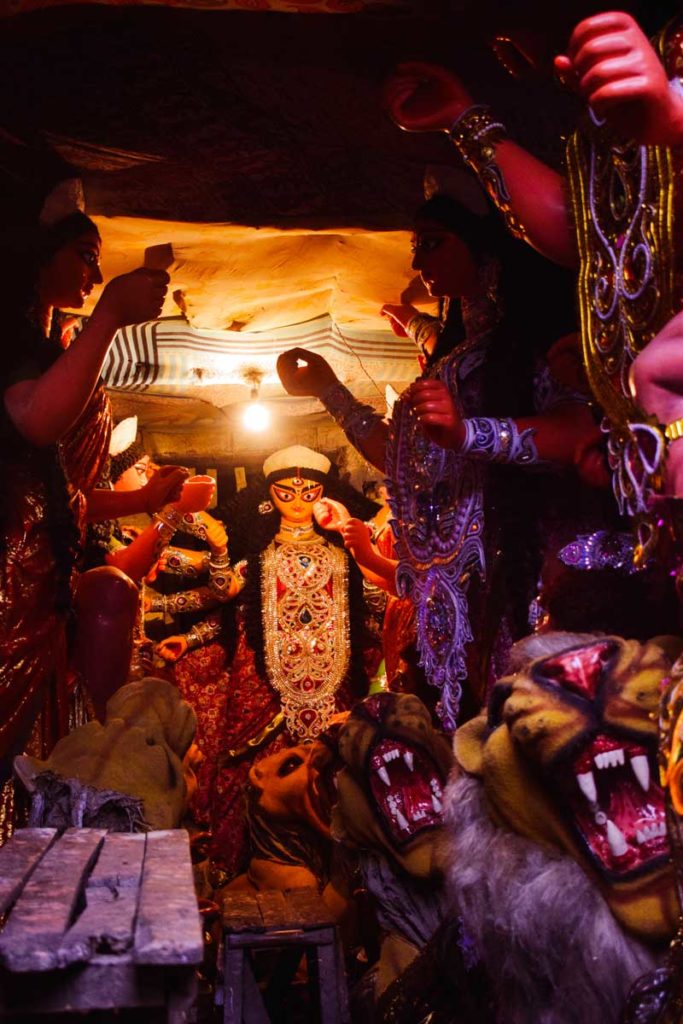
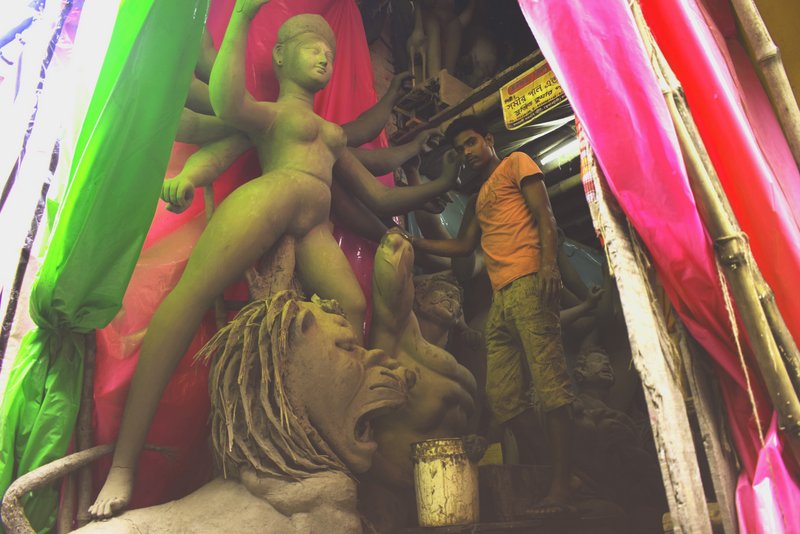

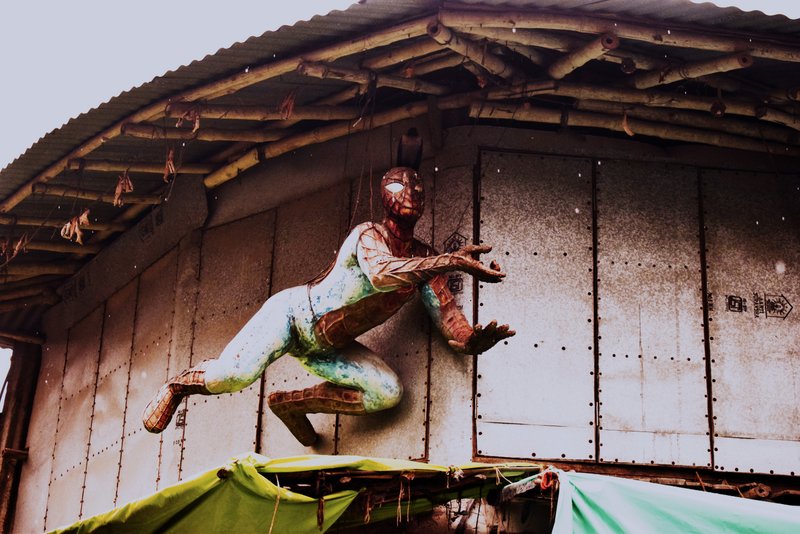
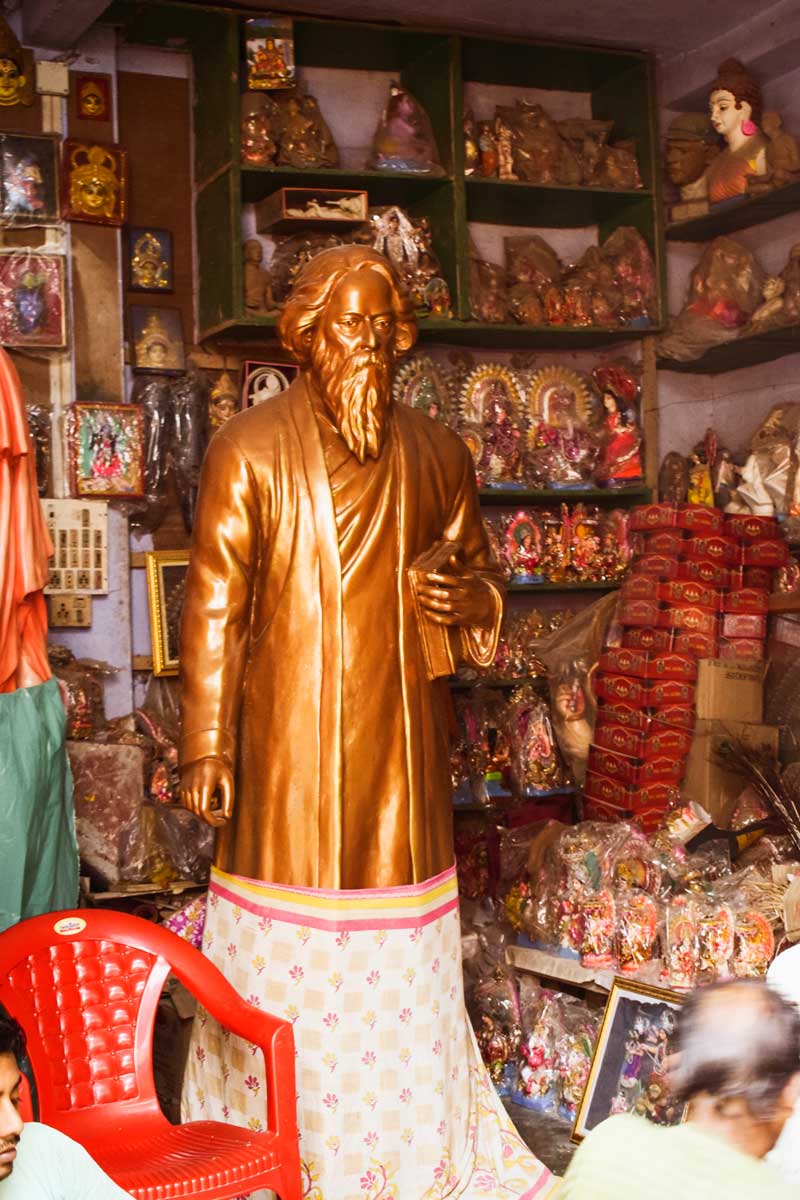
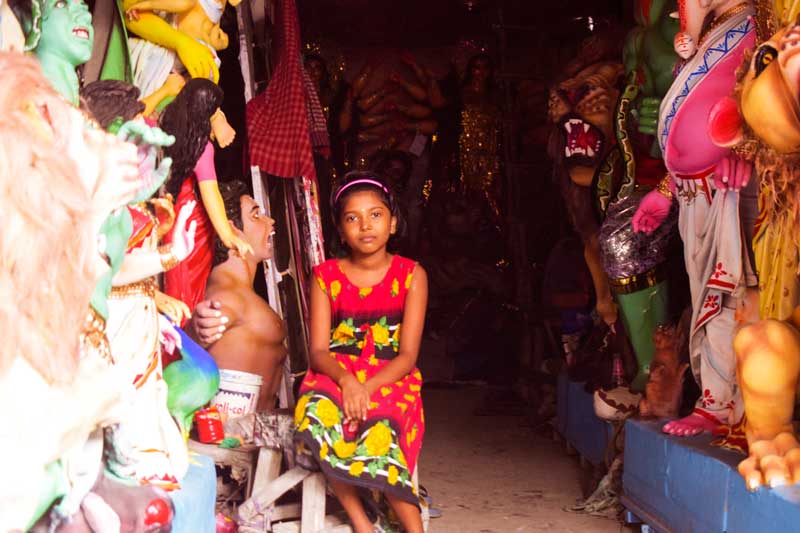

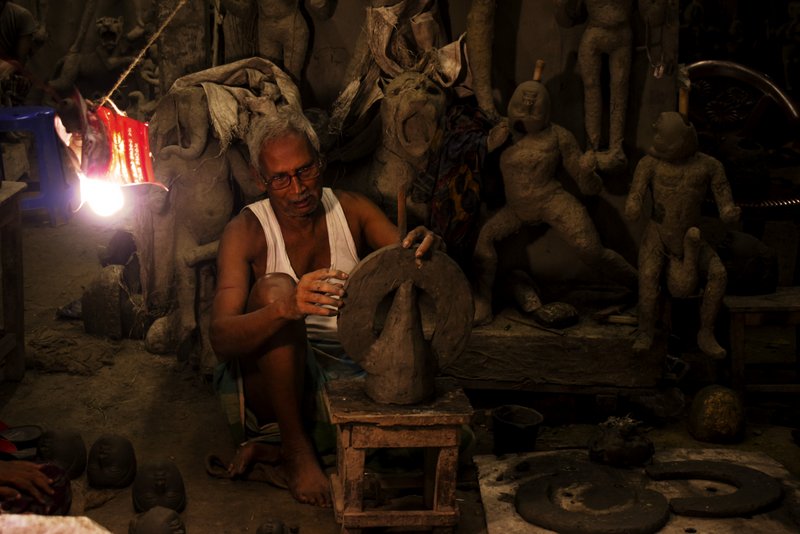




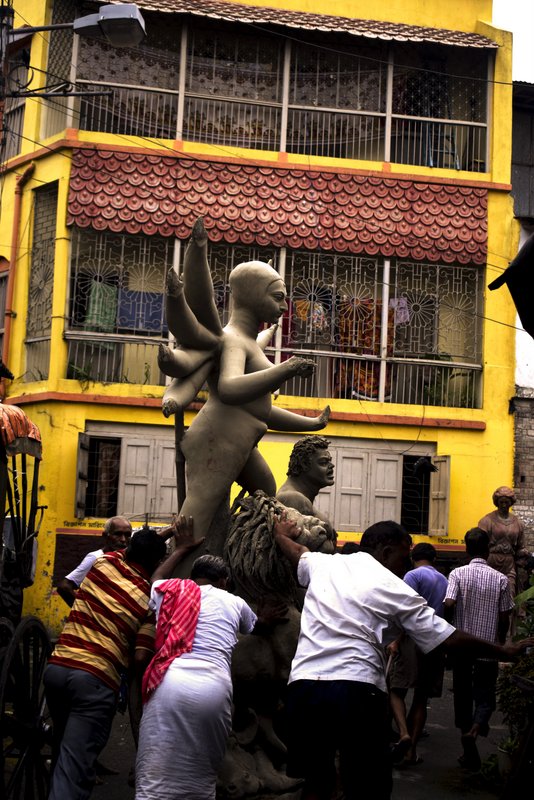
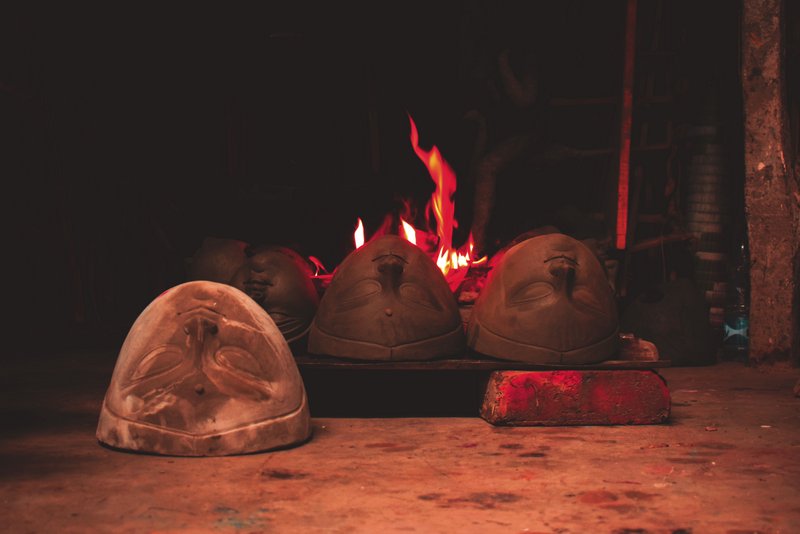
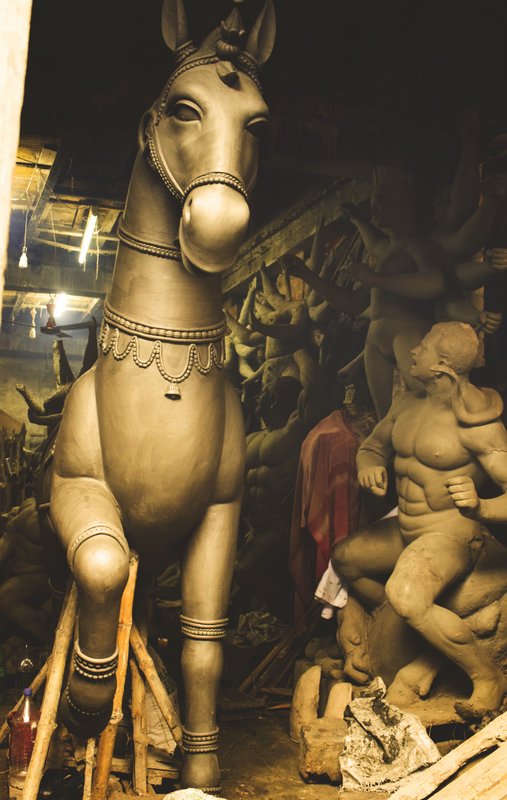
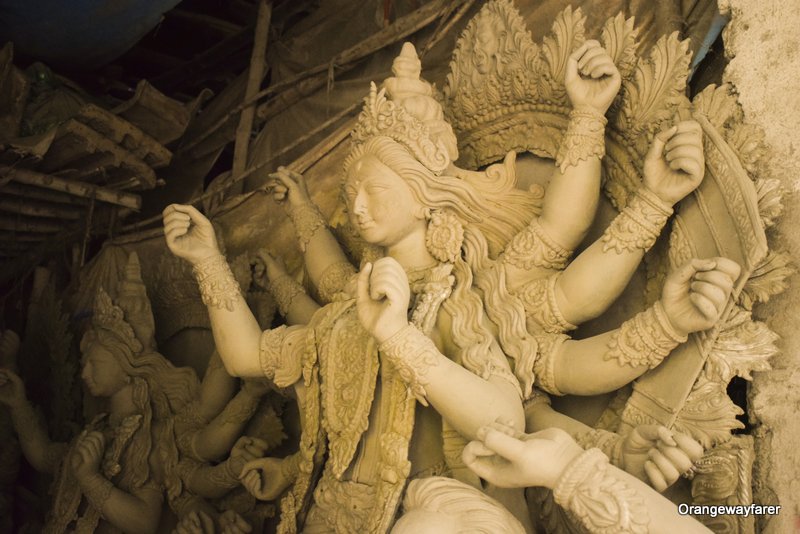
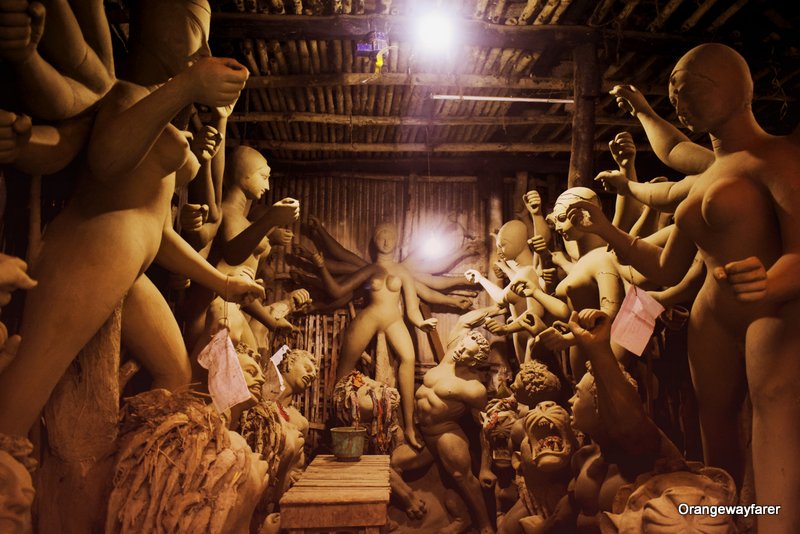
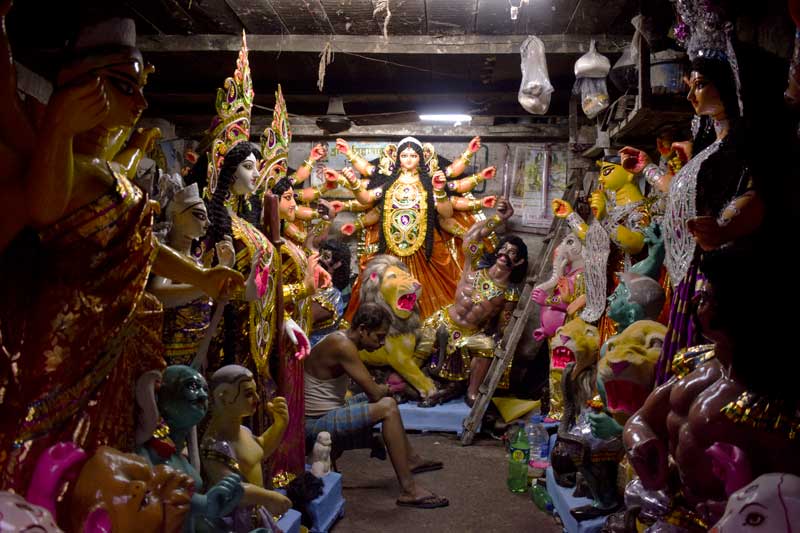
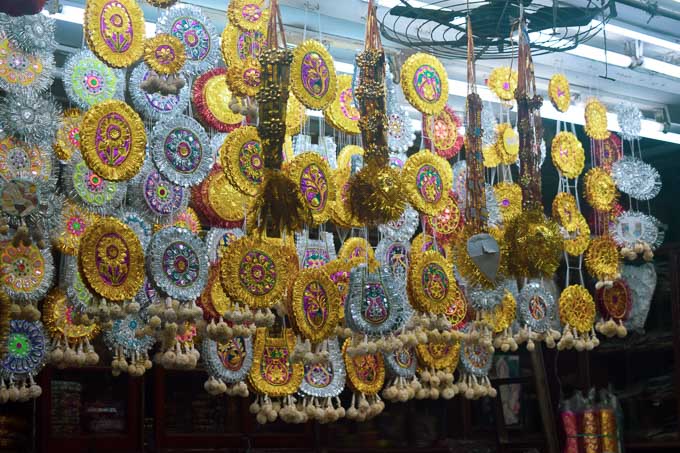
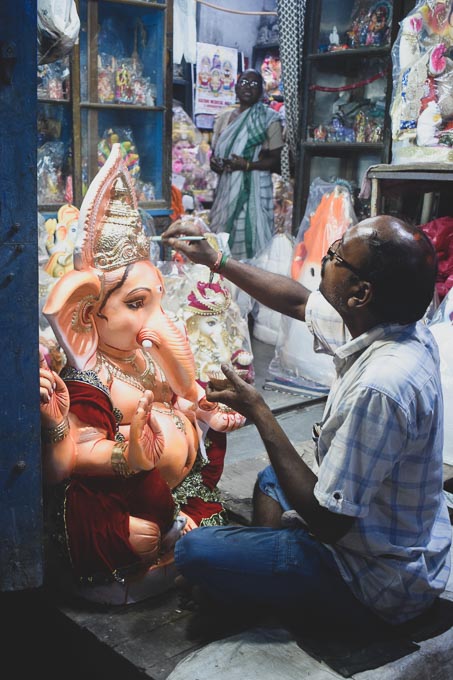
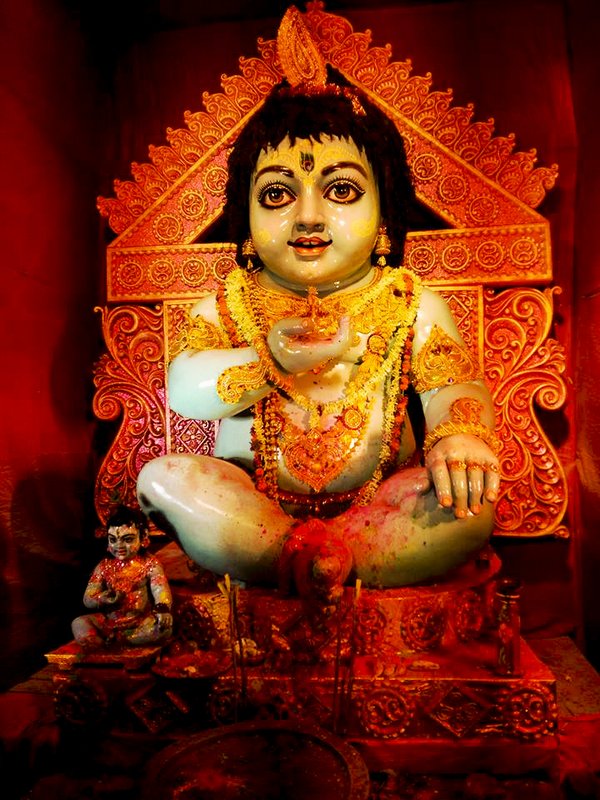

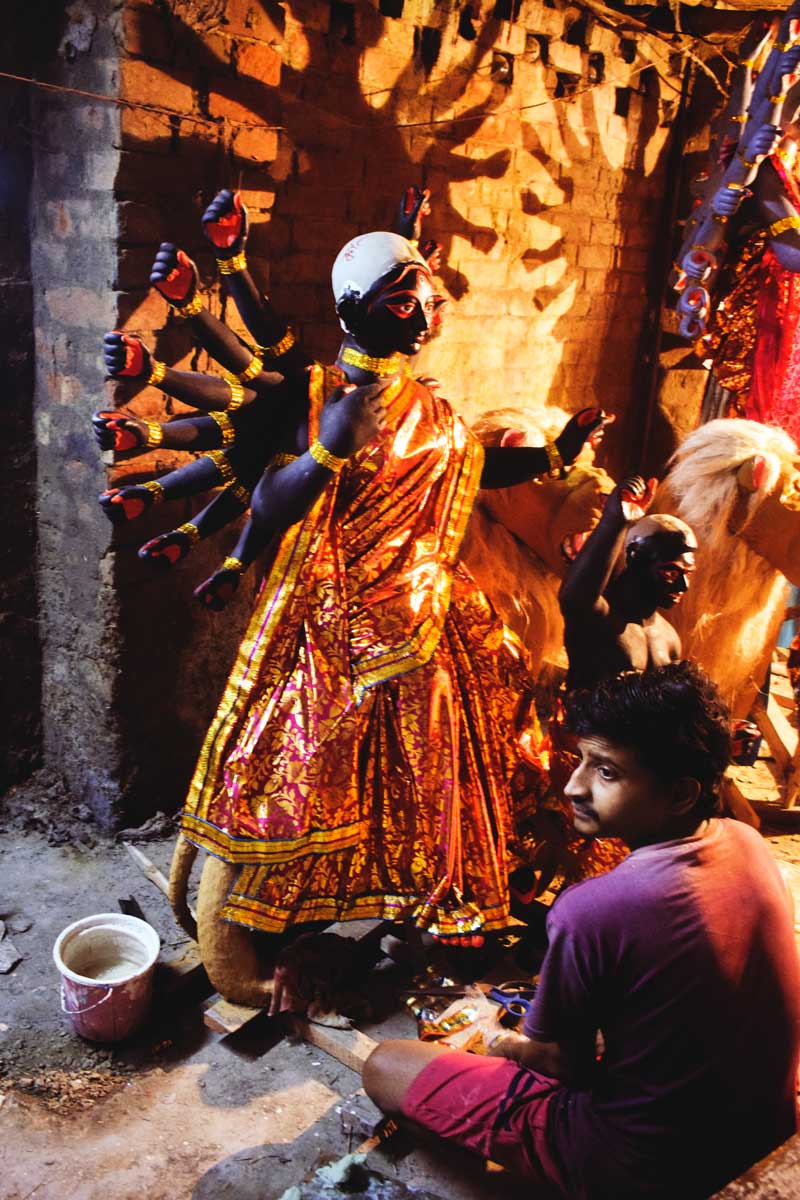
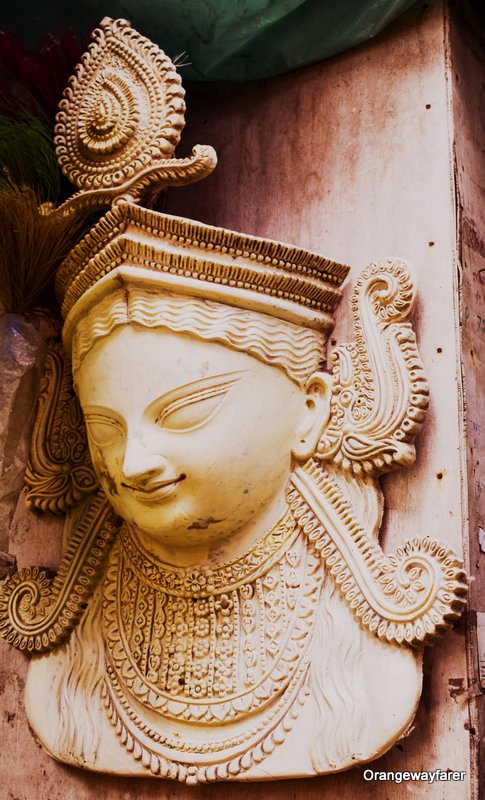


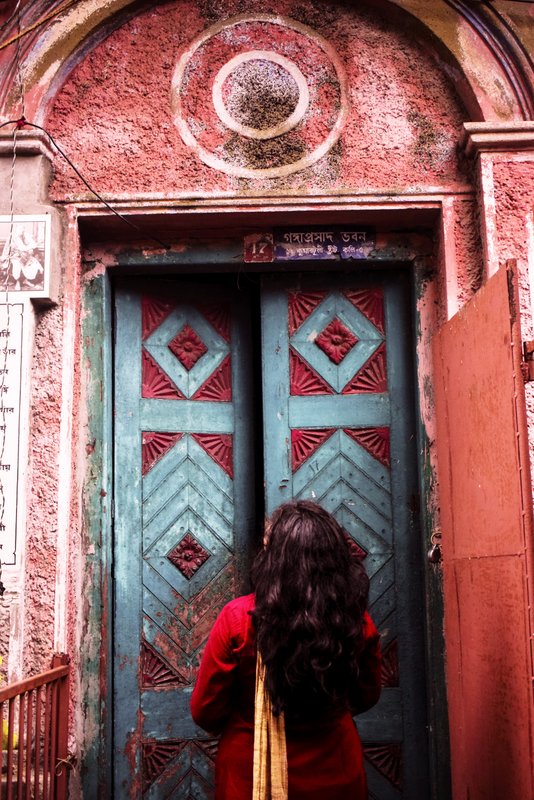
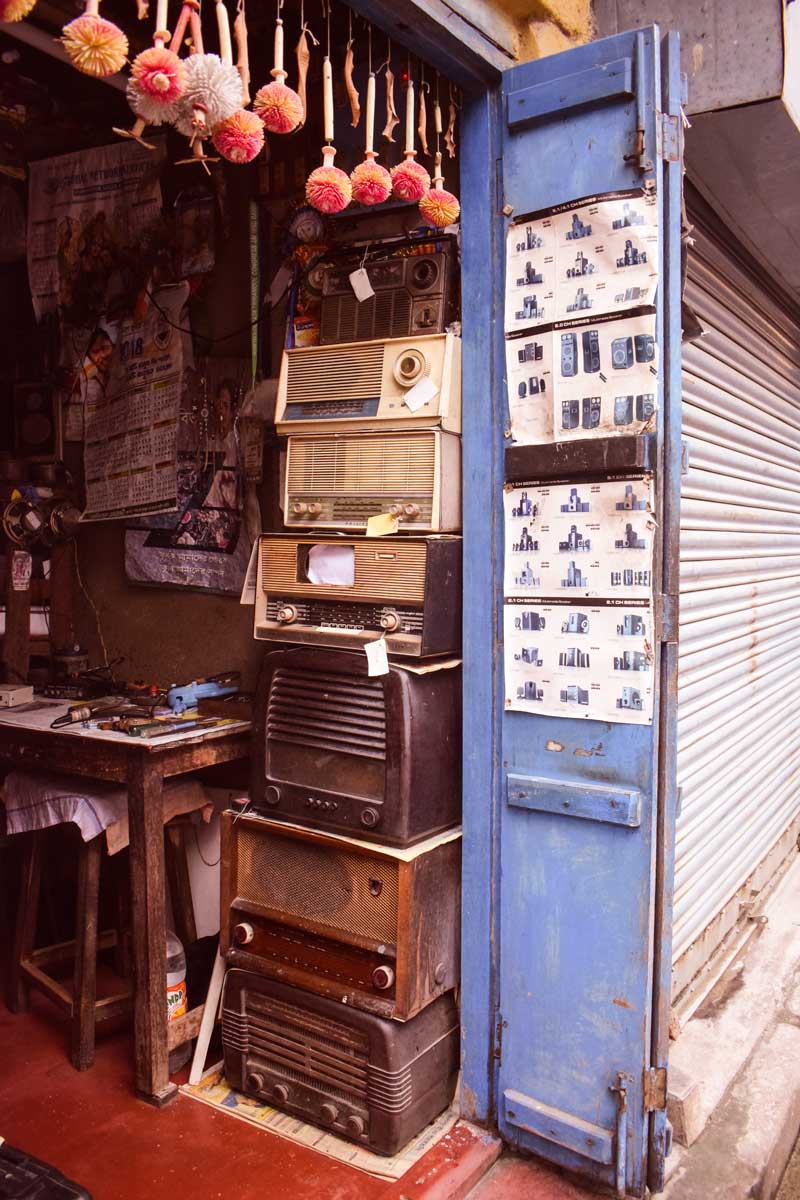
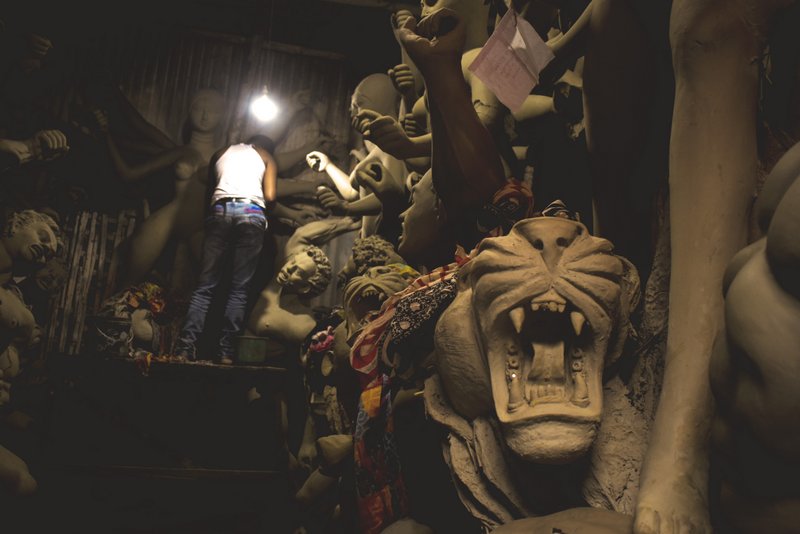

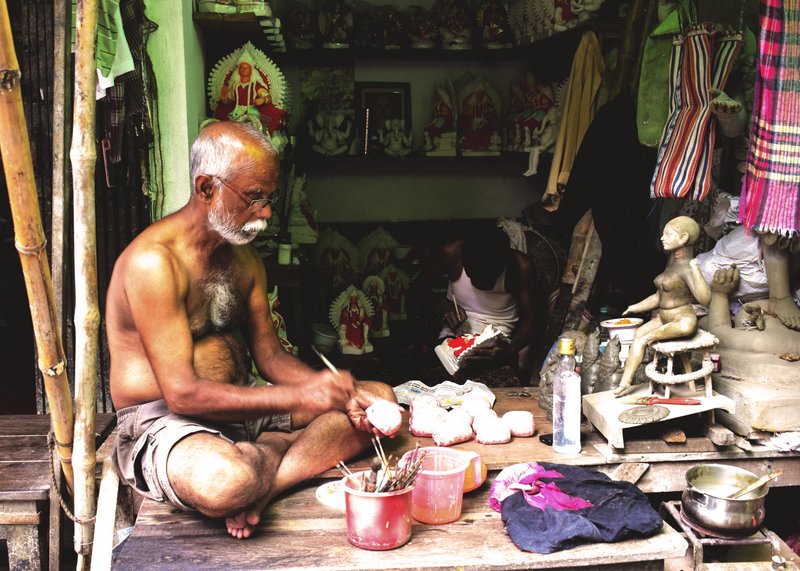



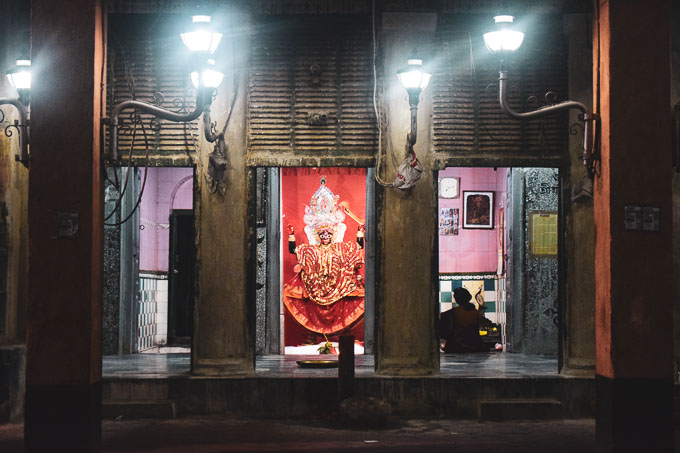
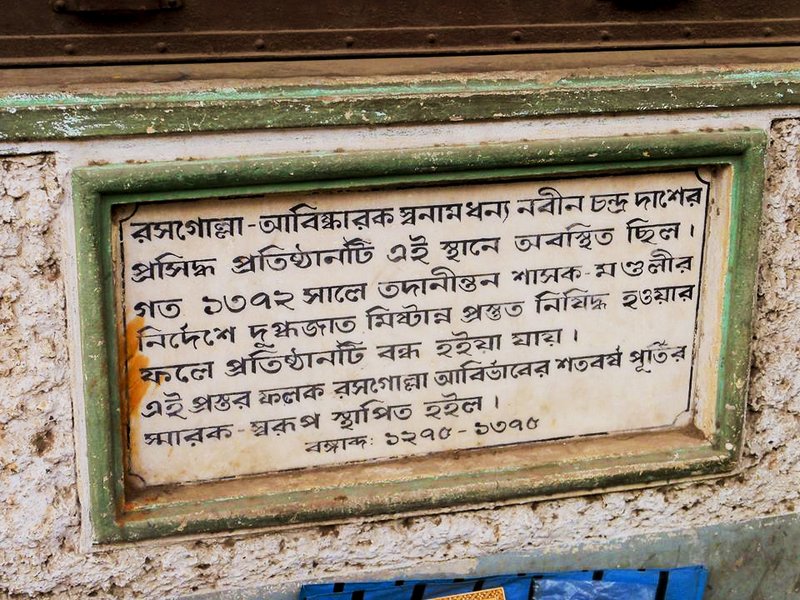
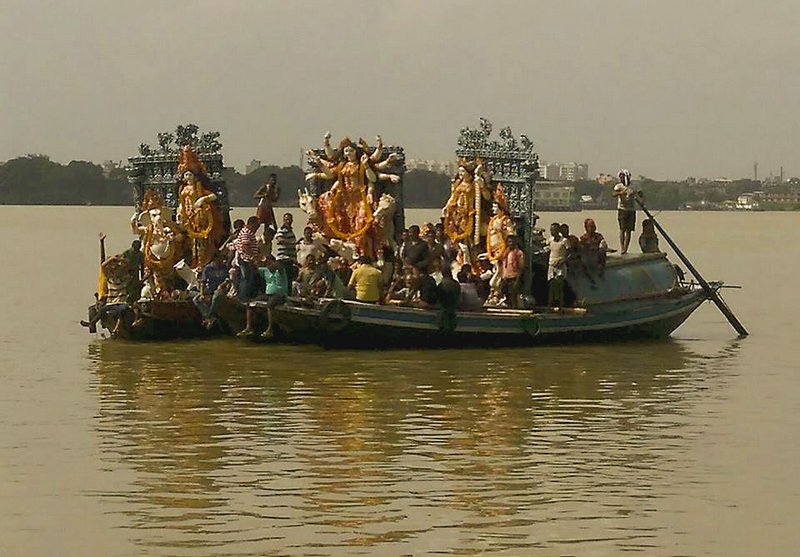
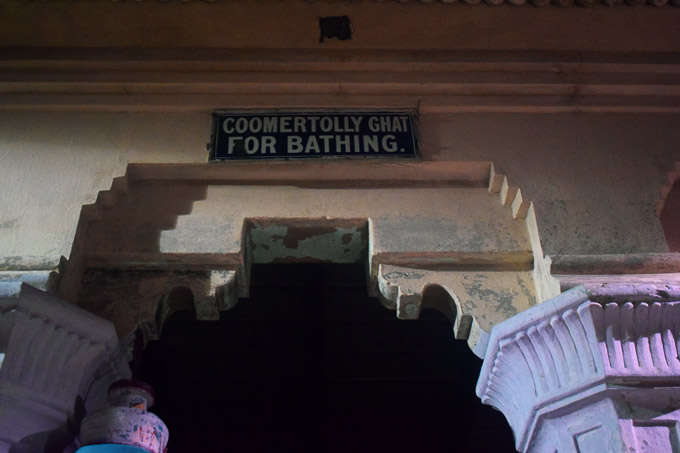

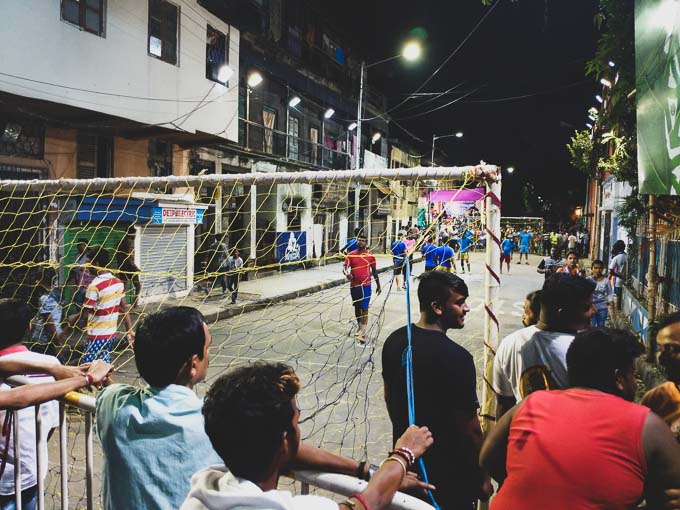
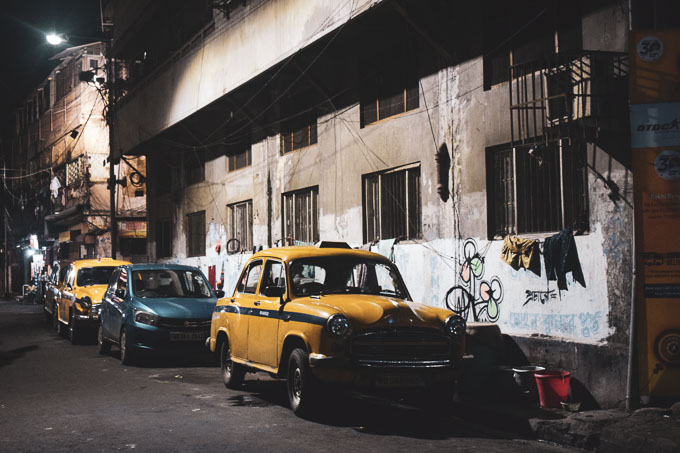
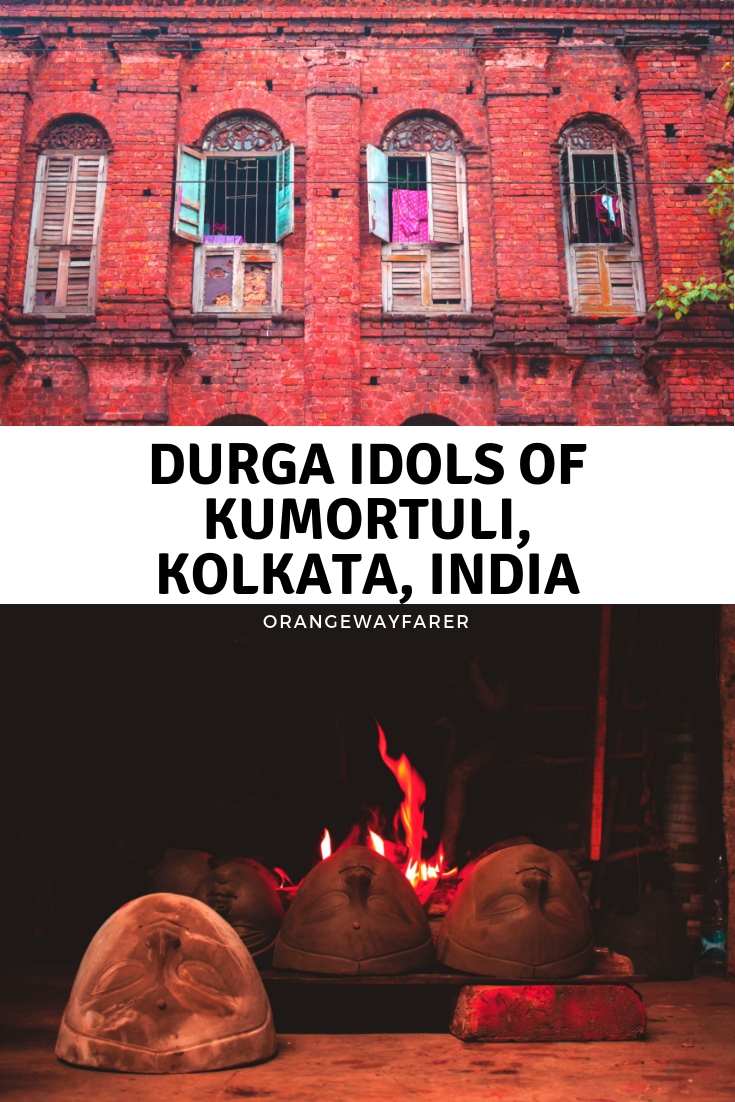
What an amazing post. Love the visuals. Brings back memories of CALCUTTA. Thanks for sharing this great post.
The details on these idols are amazing! How cool to see them actually in the process of making them. I think my favorite is the unicorn.
haha! Mine too 🙂 and the spider man as well 😀
Such an interesting post! I have never heard of this before but after this post, will have to do some research about these idols.
I love the photos showing how the idols are actually made, have never seen anything like that before. Such an amazing and beautiful post, filled with info and stunning photos. Thank you so much for sharing!
Kumor means the potters and this area is full of potters. Kumortuli is highly revered for the artisans and respected too. The history of this place goes back to 300 years, eaning as early as Kolkata was born!
I ve heard about the richness of the festivals of Bengal and all these idol making so much that I ve been mesmerised. Nice post with tons of details!